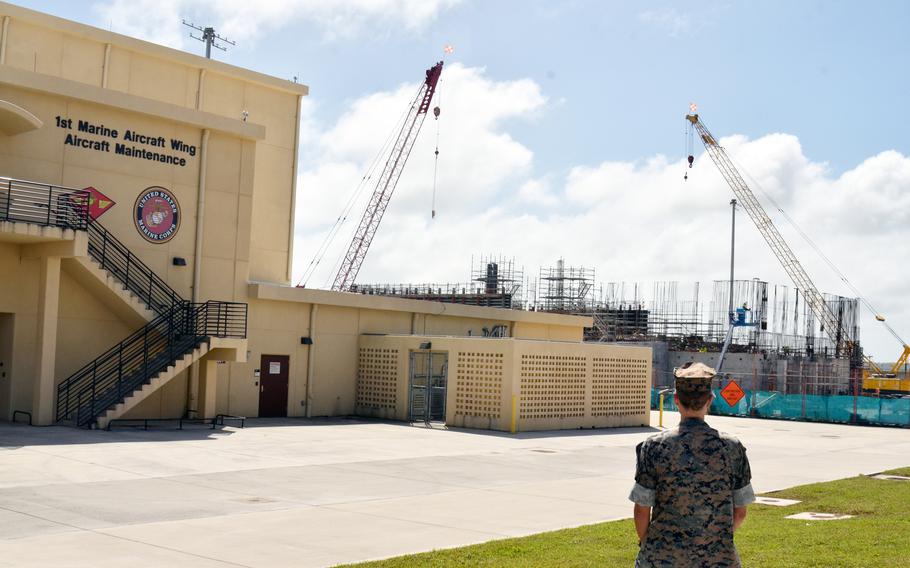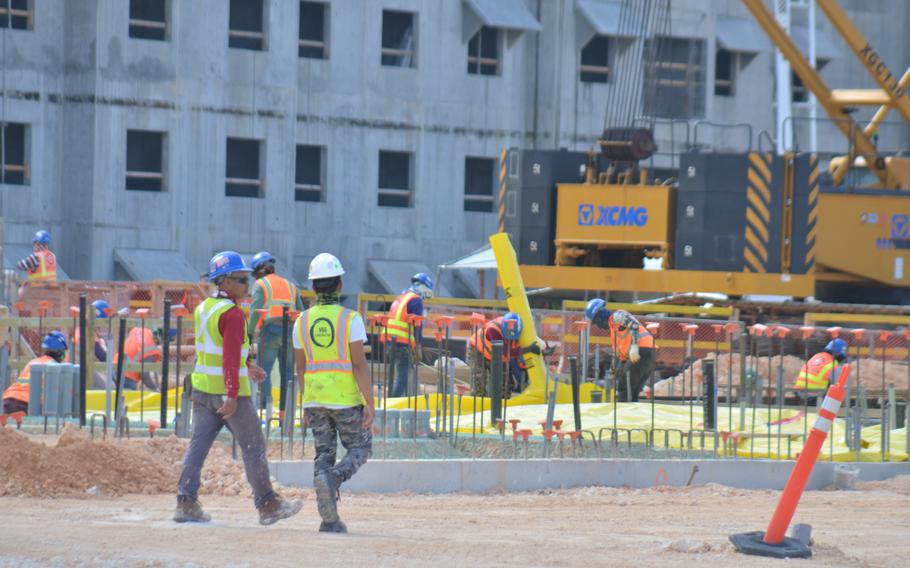
New facilities for Marines on Andersen Air Force Base, Guam, are largely complete, although work was ongoing beside one recently built hangar on Nov. 30. (Seth Robson/Stars and Stripes)
CAMP BLAZ, Guam — Starting late next year, a logistics detachment is expected to kick off a long-awaited, multiyear relocation of Marines from Okinawa to the service’s newest base in the Indo-Pacific.
The main cantonment of Camp Blaz, Gaum — named in honor of the late Brig. Gen. Vincente “Ben” Blaz, a Guam native — has been under construction since August 2017 to host about 1,300 members of the III Marine Expeditionary Force. Another 3,700 Marines will be based there as a rotational force.
The first group of Marines to move from Okinawa “will be a small detachment of logistics Marines,” Blaz spokeswoman Maj. Diann Rosenfeld told Stars and Stripes Nov. 30 during a tour of the 4,000-acre base. It’s been operated by a skeleton staff since it officially opened in January.
Rosenfeld didn’t identify the detachment that would make the first move but said additional detachments will follow to build the foundations to receive more and more Marines.
“We will be at full operational capability in 2028,” she said.
The 50 Marines already assigned to Blaz are working out of newly built offices for Marine aviation units at nearby Andersen Air Force Base on Guam’s northern coast.
Under an agreement with the United States to move Marines off Okinawa, Japan is paying $3 billion of the estimated $8.6 billion needed to build Blaz and its surrounding infrastructure.
The plan to move Marines off Okinawa was born out of massive protests following the 1995 rape of a 12-year-old Okinawan girl by two Marines and a sailor. Locals also demanded the closure of Marine Corps Air Station Futenma due to safety concerns in a densely packed urban area and sought a smaller U.S. military footprint there.
The southern island prefecture is home to about 30,000 U.S. troops — about half of all American service members based in Japan.
Hive of activity
Marine facilities on Andersen are largely complete, although work is ongoing. They include a pair of large hangars — each able to accommodate a squadron of 12 MV-22 Osprey aircraft — a logistics building and a wing support building.
A fitness center for the Marines is already up and running on Andersen and a dining facility will open in the summer, Rosenfeld said.
A live-fire complex between Blaz’s main cantonment and Andersen is also largely complete, although work is still underway on a machine gun range.
Bullets are already blasting down the Mason Live Fire Range Complex, which is being validated by the Defense Department and will have its official grand opening early next year, range director Robert Ledyard said during Stripes’ visit.
Blaz’s main cantonment, where the bulk of Marines will live and work, was a hive of activity during Stars and Stripes’ visit. Forty construction projects were ongoing, and an army of yellow-vested contract workers swarmed over gray concrete rising from brown dirt amid clouds of dust.

Construction workers build Marine Corps barracks at Camp Blaz, Guam, on Nov. 30. (Seth Robson/Stars and Stripes)
Jungle has been cleared, the terrain landscaped down to bedrock, and waterworks and underground utilities have been installed. Roads are in place, although Blaz is designed to allow Marines to walk around the campus.
A headquarters building, post office and medical clinic appear close to completion. Several multistory barracks, which will each accommodate hundreds of officers or enlisted troops, loom over the base, although each is a work in progress.
Work on the base to date has cost $2.5 billion, Rosenfeld said. U.S.-funded projects at Blaz have an estimated budget of $680 million for fiscal year 2024. Japan-funded projects there are worth an estimated $430 million for the same period.
Graves and butterflies
The Marines have preserved several ancient, unmarked graves on the base. Unearthed during construction, the graves contain the remains of indigenous people who inhabited the site in pre-colonial times.
One grave site has been landscaped with plaques added and a crypt built to inter any other remains discovered on Blaz. Other graves have been left in their natural state and will be fenced off, Rosenfeld said.
The Marines are helping conserve endangered Mariana eight-spot butterflies that flutter around Guam’s north end by creating habitats for them behind the firing ranges, she said.
Some locals, however, see potential pitfalls as the Marines build up their presence on the island.
Leland Bettis, a director of the Guam-based Pacific Center for Island Security, said the Marines had cleared hundreds of acres of pristine forest and disturbed historical sites, such as the graves, to build the base.
There’s potential for pressure on off-base housing or clashes with local culture with the arrival of so many additional Marines on Guam, he told Stars and Stripes at the Hotel Nikko Guam on Dec. 1.
Marine Maj. Sean Fay has watched the base take shape during his three-year stint on Guam, he said at Andersen a day earlier.
The aviation officer said he has helped incoming Marine, Navy and foreign aviation units take advantage of the facilities built for future Blaz troops.
Fay said Task Force 72 from Naval Air Facility Misawa in northeastern Japan has operated its P-8A Poseidon surveillance planes out of one of the Marines’ new Andersen hangars. The building has also been used by fighter jets deployed from Marine Corps Air Station Iwakuni near Hiroshima.
In January, aviators will be able to use a second hangar built for Marines at Andersen, he said.
Guam has plenty of fun things for Marines to do in their free time, added Fay, whose family lives in off-base housing near Blaz.
“I take my son to the beach and do snorkeling, swimming, surfing and hiking,” he said.
It’s been interesting watching the new base take shape, Fay added.
“When I got there, the main cantonment was just earth,” he said. “And now it’s all coming together.”